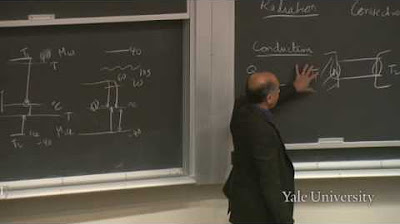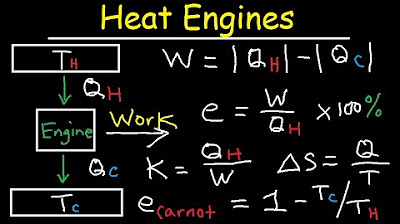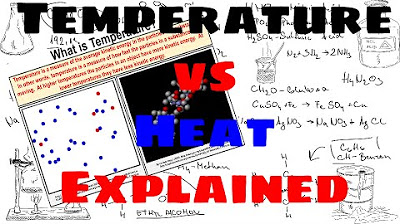Thermal Physics (AP Physics SuperCram Review)
TLDRThis educational script delves into the principles of thermal expansion, heat transfer, and thermodynamics. It explains how objects expand with heat, the role of thermal conductivity, and the ideal gas law. The script covers concepts like specific heat, latent heat, and the average speed of gas molecules. It also introduces the laws of thermodynamics, including the zeroth law, which establishes temperature as a measure of thermal equilibrium. The summary touches on the first law, energy conservation, and the second law, which dictates the direction of heat flow and the impossibility of 100% efficient heat engines.
Takeaways
- 🔥 When most objects heat up, they expand; this change in length can be calculated using the formula ΔL = αLΔT.
- 📏 The formula components: ΔL is the change in length, L is the initial length, α is the coefficient of thermal expansion, and ΔT is the change in temperature.
- ❄️ Even holes in a material expand when heated, as the expansion occurs uniformly.
- 🌡️ Thermal conductivity measures the rate at which heat flows through a substance and depends on the material's thermal conduction coefficient, surface area, temperature difference, and thickness.
- 💡 The ideal gas law can be expressed as PV = nRT (with n as the number of moles and R as the gas constant) or PV = NkT (with N as the number of molecules and k as Boltzmann's constant).
- 🔥 The formula Q gained = Q lost is used to determine heat transfer between two objects, with specific formulas for changes in temperature (Q = mcΔT) and phase changes (Q = mL).
- 🏃♂️ The root mean square speed of gas molecules is related to temperature and mass, calculated using the formula v_rms = sqrt(3kT/m).
- 🔄 The four laws of thermodynamics include the zeroth law (thermal equilibrium), the first law (conservation of energy), the second law (entropy), and specific processes like isothermal, adiabatic, isochoric, and isobaric changes.
- ⚙️ During thermodynamic processes, the change in internal energy (ΔU) can be calculated using different formulas depending on whether the gas is monatomic or not.
- 🔧 The second law of thermodynamics states that the total entropy of the universe is always increasing, and no heat engine can be 100% efficient. The efficiency of a Carnot engine is given by 1 - T_c/T_h.
Q & A
What does Delta L represent in the context of thermal expansion?
-Delta L refers to the change in length of an object due to thermal expansion.
Can you use Celsius or Kelvin when calculating the change in temperature (Delta T) for thermal expansion? Why?
-Yes, you can use Celsius or Kelvin for Delta T because it is a change in temperature, and the size of one degree is the same in both scales.
What does the coefficient of thermal conductivity (K) indicate?
-The coefficient of thermal conductivity (K) indicates the rate at which heat flows through a substance.
How is thermal conductivity related to the surface area and thickness of a material?
-Thermal conductivity is directly proportional to the surface area (A) and inversely proportional to the thickness of the material.
What are the three main ways to transfer heat?
-The three main ways to transfer heat are conduction, radiation, and convection.
What is the ideal gas law, and what do the variables represent?
-The ideal gas law can be given by PV = nRT or PV = NkT, where P is pressure, V is volume, n is the number of moles, R is the gas constant, N is the number of molecules, k is Boltzmann's constant, and T is temperature.
How do you convert from moles to molecules?
-You can convert from moles to molecules using Avogadro's number, which is 6.02 × 10^23 molecules per mole.
What is specific heat (c), and how is it measured?
-Specific heat (c) is the amount of heat required to raise the temperature of 1 kg of a material by 1°C, and it is measured in joules per kilogram per degree Celsius (J/kg·°C).
What is latent heat, and how is it different for fusion and vaporization?
-Latent heat (L) is the heat required to change the phase of a substance. The latent heat of fusion is used for solid to liquid or liquid to solid transitions, while the latent heat of vaporization is used for liquid to gas or gas to liquid transitions.
What does the zeroth law of thermodynamics state?
-The zeroth law of thermodynamics states that if two objects are each in thermal equilibrium with a third object, then they are in thermal equilibrium with each other.
How does the first law of thermodynamics relate to energy conservation in gases?
-The first law of thermodynamics states that the change in internal energy (ΔU) of a gas is equal to the heat added to the gas (Q) minus the work done by the gas (W), representing energy conservation.
What is the significance of the second law of thermodynamics in terms of entropy?
-The second law of thermodynamics states that the total entropy of the universe always increases due to irreversible processes, meaning the overall disorder in the universe is always increasing.
Why can't a heat engine be 100% efficient according to the second law of thermodynamics?
-According to the second law of thermodynamics, no heat engine can be 100% efficient because some heat will always be lost to the environment, preventing all the input heat from being converted to useful work.
What is the efficiency formula for a Carnot engine?
-The efficiency of a Carnot engine is given by the formula 1 - (Tc/Th), where Tc is the temperature of the cold reservoir and Th is the temperature of the hot reservoir.
Outlines
🌡️ Thermal Expansion and Conductivity
When most objects heat up, they expand. The change in length (Delta L) can be calculated using a formula involving the initial length (L), the coefficient of thermal expansion (Alpha), and the change in temperature (Delta T). For two-dimensional objects, expansion occurs in all directions, including holes. Thermal conductivity describes how quickly heat flows through a substance, influenced by the material's coefficient of thermal conduction (K), surface area (A), temperature difference, and thickness. It is measured in Watts. Thermal conduction is one of three heat transfer methods, along with radiation and convection.
🔄 Ideal Gas Law and Heat Transfer
The ideal gas law is expressed as PV = nRT or PV = NkT, where n is the number of moles, R is the gas constant (8.31 J/mol·K), N is the number of molecules, and k is Boltzmann's constant (1.38 × 10^-23 J/K). Moles can be converted to molecules using Avogadro's number (6.02 × 10^23). When heat transfers between objects, Q gained equals Q lost. For temperature changes, use Q = mcΔT, and for phase changes, use Q = mL. Specific heat (c) indicates the energy needed to raise the temperature of 1 kg of a material by 1°C, while latent heat (L) pertains to phase changes. Calculations involve sequential heating and phase changes, ensuring energy conservation between interacting objects.
🚀 Root Mean Square Speed of Gas Molecules
The root mean square (RMS) speed of gas molecules provides an average speed based on temperature (T in Kelvin) and the mass of a single gas molecule (m in kilograms). The mass of a molecule approximates the sum of protons and neutrons, converted to kilograms using atomic mass units (AMU). For gases with multiple atoms per molecule, adjustments are made. The average kinetic energy of a gas molecule is given by 1/2 mv^2, substituting v with RMS speed, resulting in 3/2 kT. There are four thermodynamic laws, starting with the zeroth law, which defines thermal equilibrium and underpins the concept of temperature.
📉 Thermodynamic Processes
Thermodynamic processes can be isothermal (constant temperature), adiabatic (no heat transfer), isochoric (constant volume), or isobaric (constant pressure). The first law of thermodynamics states ΔU = Q + W, where ΔU is the change in internal energy, Q is heat added, and W is work done on the gas. Work done can be visualized as the area under a PV diagram path, with sign conventions for expansion and compression. For monatomic gases, ΔU = 3/2 nRΔT. Heat (Q) is calculated from the first law, and cyclic processes have ΔU = 0. The second law of thermodynamics introduces entropy, indicating the universe's increasing disorder, and sets limits on heat engine efficiency.
♾️ Entropy and Efficiency
Entropy, a measure of disorder, always increases in the universe. While localized entropy can decrease (e.g., water freezing), the total entropy of the system and surroundings increases. The second law also asserts that no heat engine can be 100% efficient due to inevitable heat loss. Efficiency is the ratio of work done to total heat input, influenced by temperature differences between heat source and sink. The Carnot engine represents the theoretical maximum efficiency, dependent on the temperatures of the heat source (Th) and sink (Tc), calculated as 1 - (Tc/Th). Practical applications require considering real-world irreversibilities and energy conservation principles.
Mindmap
Keywords
💡Thermal Expansion
💡Thermal Conductivity
💡Heat Transfer
💡Ideal Gas Law
💡Specific Heat
💡Latent Heat
💡Root Mean Square Speed
💡Molar Mass
💡Thermodynamics Laws
💡Entropy
💡Carnot Engine
Highlights
Most objects expand when heated, which can be calculated using the formula for change in length: ΔL = αLΔT, where α is the coefficient of thermal expansion.
Thermal conductivity measures the rate of heat flow through a substance and is proportional to the material's surface area and temperature difference, but inversely proportional to its thickness.
Thermal conduction, radiation, and convection are the three methods of heat transfer.
The ideal gas law is expressed as PV = nRT for moles of gas and PV = NkT for molecules of gas.
Heat transfer between objects can be calculated with Q gained = Q lost, and phase changes are calculated using Q = mL, where L is the latent heat.
The specific heat (c) is the amount of heat required to raise the temperature of 1 kg of a substance by 1°C.
The root mean square speed of gas molecules provides the average speed, and is calculated using Boltzmann's constant and temperature.
The mass of a gas molecule can be approximated using the atomic mass unit (AMU) or the molar mass.
Monatomic gases, like helium and neon, consist of single atoms per molecule.
The first law of thermodynamics is a statement of energy conservation, expressed as ΔU = Q + W, where ΔU is the change in internal energy.
In isothermal processes, the temperature remains constant; in adiabatic processes, no heat is transferred; in isochoric processes, the volume remains constant; and in isobaric processes, the pressure remains constant.
The second law of thermodynamics states that the total entropy of the universe is always increasing due to irreversible processes.
Entropy, a measure of disorder, increases overall in the universe, even if it decreases locally, as in the case of water freezing into ice.
No heat engine can achieve 100% efficiency; some energy is always lost as waste heat.
The Carnot engine represents the most efficient heat engine possible, with efficiency dependent on the temperatures of the heat source and sink.
Transcripts
Browse More Related Video

21. Thermodynamics

The Physics of Heat: Crash Course Physics #22

02 - Introduction to Physics, Part 2 (Thermodynamics & Waves) - Online Physics Course

23. The Second Law of Thermodynamics and Carnot's Engine

Carnot Heat Engines, Efficiency, Refrigerators, Pumps, Entropy, Thermodynamics - Second Law, Physics

Temperature vs Heat - Explained
5.0 / 5 (0 votes)
Thanks for rating: